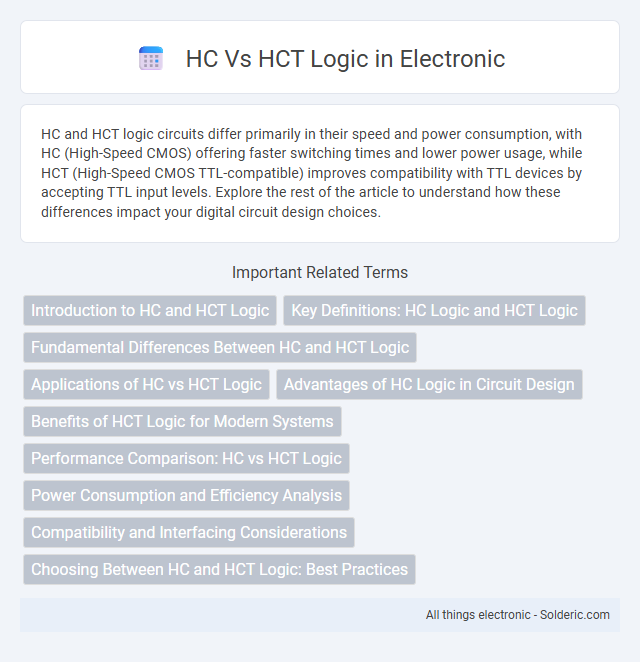HC and HCT logic circuits differ primarily in their speed and power consumption, with HC (High-Speed CMOS) offering faster switching times and lower power usage, while HCT (High-Speed CMOS TTL-compatible) improves compatibility with TTL devices by accepting TTL input levels. Explore the rest of the article to understand how these differences impact your digital circuit design choices.
Comparison Table
| Aspect | HC Logic | HCT Logic |
|---|---|---|
| Definition | Hard Constraint logic focuses on mandatory rules that must always be satisfied. | Hard Constraint with Tolerance logic allows minor violations within predefined limits. |
| Flexibility | Rigid, no exceptions allowed. | Flexible, supports controlled exceptions. |
| Use Case | Applications requiring strict rule enforcement, e.g., safety systems. | Systems where soft constraints or trade-offs are acceptable, e.g., scheduling with minor delays. |
| Error Handling | Violations cause immediate failure or rejection. | Violations tolerated up to threshold, with warnings or penalties. |
| Complexity | Simpler logic due to strict conditions. | Increased complexity managing tolerance ranges. |
Introduction to HC and HCT Logic
HC Logic (Hybrid Classical Logic) combines classical logic principles with additional modal operators to handle uncertainty and temporal aspects effectively. HCT Logic (Hybrid Computation Tree Logic) extends classical CTL by incorporating hybrid features that enable referencing individual states within computation trees, enhancing expressiveness in model checking. Understanding these logics helps you apply formal reasoning in complex systems analysis and verification.
Key Definitions: HC Logic and HCT Logic
HC Logic refers to Hierarchical Control Logic, which structures control systems in a top-down manner to simplify complex processes by breaking them into manageable sub-modules. HCT Logic, or Hierarchical Control with Timing Logic, builds upon HC Logic by incorporating explicit timing constraints and synchronization mechanisms to optimize process coordination. Understanding these definitions helps you design efficient control systems that balance modularity with precise temporal control.
Fundamental Differences Between HC and HCT Logic
HC logic operates primarily with combinational circuits emphasizing computation through basic logic gates, while HCT logic integrates transistor threshold voltage adjustments to achieve faster switching speeds and lower power consumption. The fundamental difference lies in HCT's compatibility with TTL logic levels and improved noise margins compared to standard HC logic, making it more suitable for mixed-signal environments. Your choice between HC and HCT logic should consider speed requirements, power efficiency, and system compatibility.
Applications of HC vs HCT Logic
HC Logic excels in applications requiring hierarchical control and modular reasoning, such as automated theorem proving and logic programming, due to its ability to handle constraints effectively. HCT Logic extends these capabilities by integrating temporal reasoning and handling hybrid systems, making it suitable for real-time system verification and model checking in cyber-physical systems. Both logics serve crucial roles in artificial intelligence, with HC Logic focusing on constraint satisfaction problems and HCT Logic enhancing applications involving time-dependent data and hybrid automata.
Advantages of HC Logic in Circuit Design
HC logic offers faster switching speeds and lower propagation delays compared to HCT logic, making it ideal for high-frequency circuit designs. Its improved noise immunity and consistent output voltage levels enhance overall circuit reliability and performance. You benefit from reduced power consumption and better compatibility with modern CMOS processes, optimizing your digital circuit efficiency.
Benefits of HCT Logic for Modern Systems
HCT (High-speed CMOS with TTL compatibility) Logic offers improved power efficiency and faster switching speeds compared to standard HC (High-speed CMOS) Logic, making it ideal for modern high-frequency applications. Its enhanced noise tolerance and seamless TTL interfacing provide greater design flexibility and reliability in complex digital circuits. These benefits contribute to optimized performance and reduced power consumption in contemporary microprocessor and communication systems.
Performance Comparison: HC vs HCT Logic
HC logic offers faster switching speeds and lower propagation delay compared to HCT logic, making it ideal for high-performance applications. HCT logic, while slightly slower, provides better noise immunity and is more compatible with TTL inputs. Your choice between HC and HCT will depend on whether speed or noise tolerance is the priority in your circuit design.
Power Consumption and Efficiency Analysis
HC (High-Speed CMOS) and HCT (High-Speed CMOS with TTL Compatibility) logic families differ notably in power consumption and efficiency, with HC circuits typically operating at lower power levels due to reduced quiescent current. HCT devices, designed for TTL input levels, exhibit slightly higher power consumption but maintain efficiency in interfacing with standard TTL logic, balancing speed and power use. The trade-off in power efficiency makes HC more suitable for battery-powered applications, while HCT is preferred where TTL compatibility and speed are critical.
Compatibility and Interfacing Considerations
HC and HCT logic families differ primarily in their voltage compatibility, with HCT devices designed to interface directly with TTL (Transistor-Transistor Logic) levels, accepting a lower threshold voltage around 0.8V for logic HIGH. HC logic circuits generally operate at standard CMOS voltage levels, resulting in compatibility challenges when interfacing with TTL signals without level shifting. Proper interfacing considerations include ensuring input thresholds match the driving logic levels to avoid signal integrity issues and choosing appropriate pull-up or pull-down resistors as needed for reliable communication between HC and HCT devices.
Choosing Between HC and HCT Logic: Best Practices
Choosing between HC and HCT logic depends on application requirements like speed, cost, and integration complexity. HC logic offers efficient, high-speed processing suitable for time-critical systems, while HCT logic provides enhanced noise immunity and lower power consumption, ideal for mixed-signal environments. Best practices recommend evaluating timing constraints, power budgets, and environmental conditions to select the optimal logic family for system stability and performance.
HC vs HCT Logic Infographic

 solderic.com
solderic.com